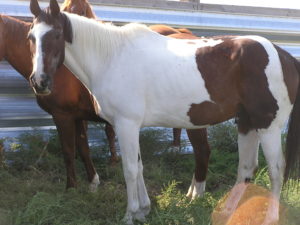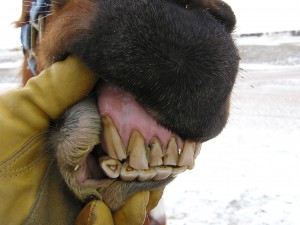Elderly Equines

As horses get older, their body condition usually gets poorer. Nutritional requirements change and hoof growth rate slows down. This horse lived to be almost 40 years old.
The average life expectancy of a horse is around twenty-five or thirty years of age. One year of horse age is comparable to 3 years of human age. In other words a 25 year old horse would be comparable to a 75 year old human and a 30 year old horse would be comparable to a 90 year old human. Domesticated horses live longer than wild horses. These days, thanks to quality feeds and excellent care of well-informed horse owners, horses are living even longer. Recently, someone brought a horse to the school to be trimmed that was over 40 years old! According to the Guinness Book of World Records, the oldest horse ever recorded is Old Billy, a cob/shire horse born in England. He died at age 62 in 1822. The oldest pony of verifiable record was Sugar Puff, a Shetland from Sussex U.K. He died at age 56 in 2007.
As a horse matures, its nutritional requirements change. The most critical factor for growing horses is protein. Protein is needed in relatively high amounts by foals for normal growth. However, a mature horse needs a minimum of 8 to 10 percent crude protein to be maintained. If a ration contains more than required amount of protein, it is converted into stored fat and ammonia that is excreted in the urine. Since protein is the most expensive part of the ration, it is wise to feed only the required amount. These amounts have been determined by scientific studies and published by the National Research Council in Nutrient Requirements of Light Horses.
Energy requirements vary with the work a horse does. A horse that does little work needs very little if any concentrated energy such as is found in grain. However, in order to maintain its weight, a horse that works hard requires more energy than grass or hay can supply. When a horse starts to get fat, you should reduce the energy portion of the ration. To put weight on a skinny or an aged horse, you should increase the energy portion of the ration. This should be done with judgment and gradually as a sudden increase in energy can cause horses to colic or founder. Senior horses may need extra energy in the form of pelleted sweet feed to maintain their weight.

As horses age and their teeth wear out, moistened pellets or pulp may be fed to keep the horse in good condition.
As horses get older, their teeth condition becomes poorer. Older horses with poor or missing teeth seem to do better on cubes or pellets than coarse stemmed hay. In addition, protein, fiber and phosphorous are more difficult for aged horses to digest so moistened pellets or pulp are a good way to improve a horse’s condition. Feed supplements are usually not necessary unless something is known to be missing from the ration – for example, if you only have access to poor quality hay.
Horses’ feet don’t grow as much as they get older. Hoof growth rate is highly correlated to heart rate. Young animals have a heart rate at least twice as fast as older animals. Young horses’ feet grow much faster. Studies have shown that a foal’s hoofs grow at 0.6 inches per month while an aged horse’s hoofs grow at 0.25 inches per month. Older horses may not need to be trimmed or shod as often because of this. If an older horse has a diseased hoof, a supplement that stimulates hoof growth (such as Farrier’s Formula by Life Data Labs) may be necessary.
While shoeing or trimming older horses, remember to exercise patience and hold their limbs closer to the ground as they may be suffering from stiff joints. The Hoofjack Geriatric Hoof Stand is a helpful tool when working on aged horses.
Even though horses can do less rigorous activities as they age, they may still be of value as companion animals or riding animals for young children and those with disabilities. A well-trained older horse for an inexperienced rider can be invaluable because at least one of them will have some judgment! Knowing how to care for these beloved animals is important so we can enjoy them for many years.
Related Posts
-
This month, the House Judiciary Committee will vote on the 2...Jan 05, 2018 / 0 comments
-
I hope everyone has the privilege of being taught by a great...Oct 03, 2019 / 0 comments
-
We’ve had many questions about hoof supplements. The f...Jan 31, 2019 / 0 comments
Blog Categories
- Anatomy
- Best Business Practices
- Conformation
- Current Events
- Customer Service
- Draft Horse Shoeing
- Equine Soundness
- Essential Anatomy Kit
- Farrier Careers
- Farrier training
- Foal soundness
- Horse Care
- Horse Foot Care
- Horse Owner Tips
- Horsemanship
- Horseshoeing
- Horseshoeing History
- Iron and Forge Work
- Student Spotlight
- Uncategorized
- Veterinary Care
Blog Archives
Contact Us
Butler Professional Horseshoeing School
495 Table Road
Crawford, NE 69339
(800) 728-3826
jacob@dougbutler.com
Subscribe to Our Blog
Get Our Free e-Book!
If you think you want to become a farrier (or know someone who does), this book can help you make that decision. Horse owners will learn the importance of choosing a qualified farrier and how to select the “right” one.
[ Get the e-Book Now! ]
- Follow:
